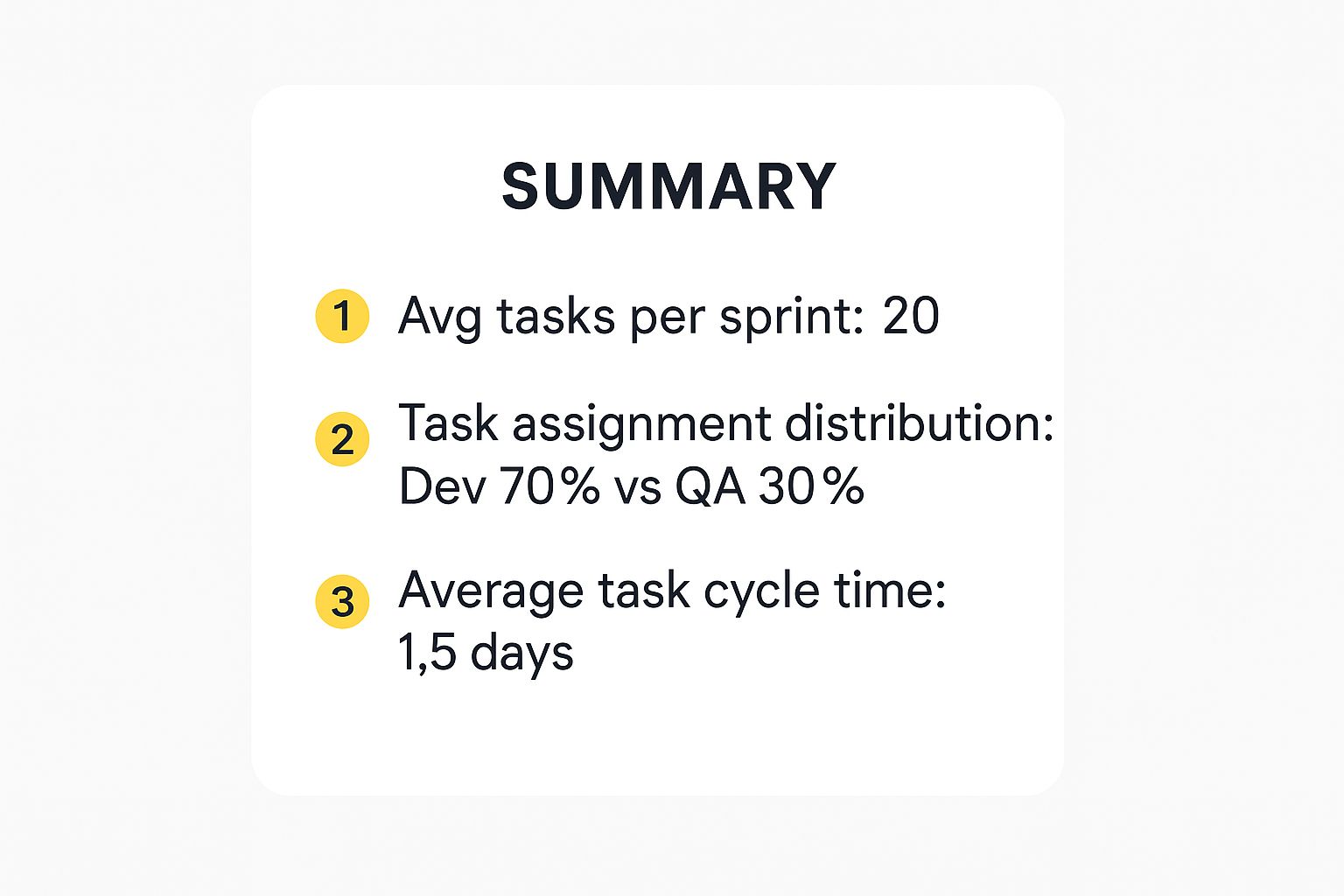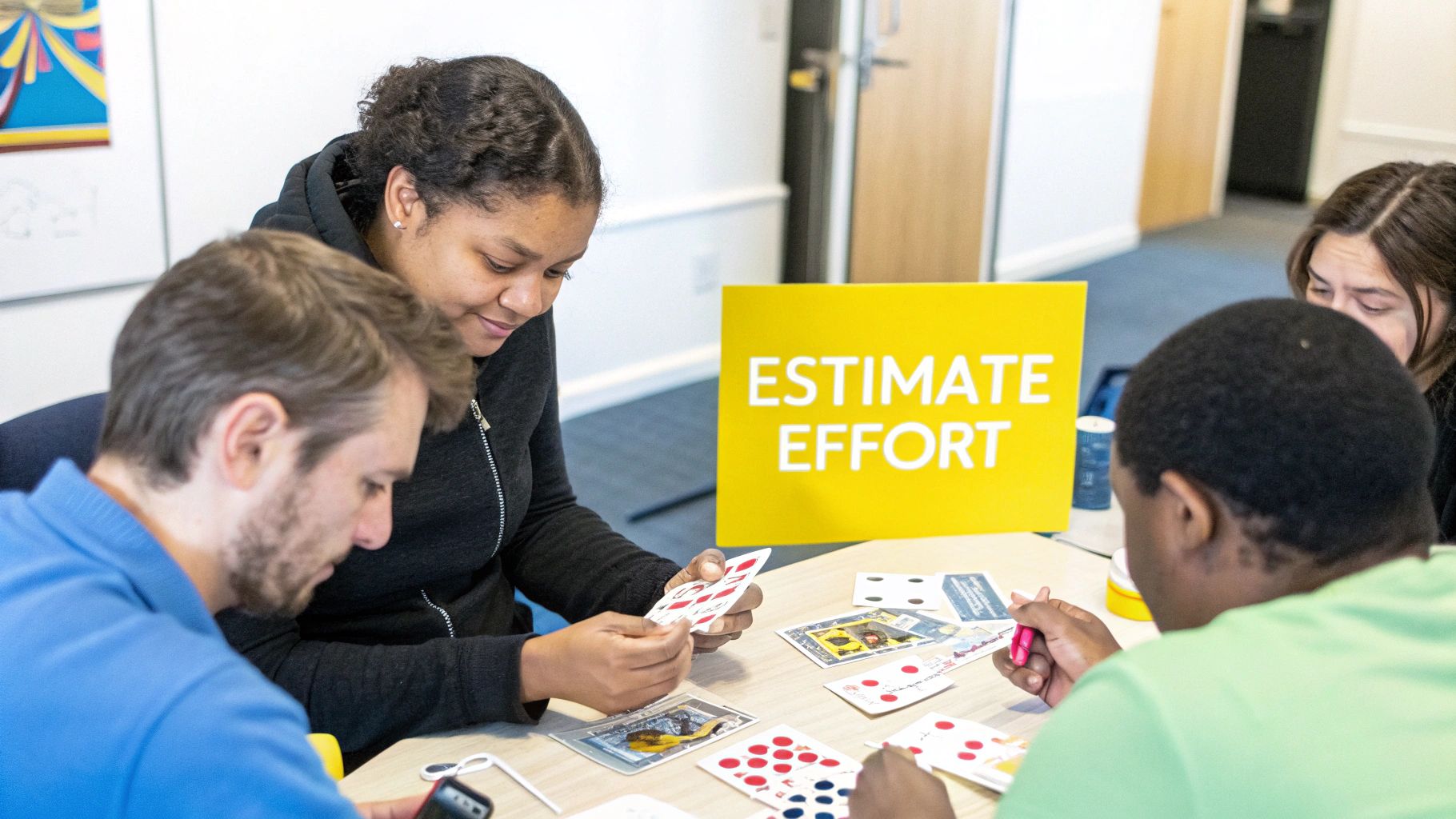A productive sprint planning in agile methodology doesn’t just happen by magic. It’s the direct result of putting in the right groundwork beforehand. The quality of your sprint planning meeting is directly tied to the quality of your prep work, ensuring the team can make focused, high-value decisions instead of getting bogged down in chaos.
Setting the Stage for a Successful Sprint

The real secret to a smooth sprint planning session is what happens before anyone even walks into the room. Skip this crucial prep, and your meeting can quickly spiral into a confusing, unproductive mess.
The absolute foundation of this preparation is a well-refined product backlog. Think of it as the single source of truth for everything the team could possibly work on. A “groomed” or “refined” backlog isn’t just a long to-do list; it’s a prioritized, well-understood collection of user stories ready for discussion.
The Product Owner’s Role in Preparation
The Product Owner is the chief architect of this preparation phase. Their main job is to make sure the user stories at the very top of the backlog are genuinely ready for the team to pull into a sprint. A “ready” story is clear, concise, and, most importantly, testable.
This means crafting solid acceptance criteria for each story. These criteria are non-negotiable—they remove ambiguity and clearly define what “done” looks like from a user’s perspective, heading off misunderstandings before they can start. To truly nail this, it’s vital to incorporate broader product management best practices, which provide the strategic context for effective agile processes.
A sprint planning meeting without a refined backlog is like a chef trying to cook a gourmet meal with an empty pantry. The right ingredients must be gathered, prepped, and ready before you can even think about starting.
Understanding Team Velocity and Capacity
Another critical piece of the puzzle is having a realistic grasp of the team’s capacity. This is where historical data—specifically team velocity—becomes your most valuable guide. Velocity is simply the average amount of work a team completes during a sprint, usually measured in story points.
It’s crucial to remember that this isn’t a rigid performance metric to beat team members over the head with. It’s a forecasting tool. By looking at the velocity from the last few sprints, the team gets a realistic preview of what they can likely accomplish.
Of course, this calculation has to account for real-world variables:
- Team availability: Is anyone on vacation or out sick?
- Public holidays: Will a holiday shorten the sprint?
- Company events: Are there any all-hands meetings or training sessions on the calendar?
Subtracting capacity for these events gives you a much more accurate forecast for the upcoming sprint. This proactive approach prevents the all-too-common problem of overcommitment and helps set a sustainable pace—a true cornerstone of a healthy agile environment. For a deeper dive into this, check out this excellent ultimate guide to sprint planning for more detailed strategies.
Structuring Your Sprint Planning Meeting Agenda

An effective sprint planning meeting absolutely hinges on a well-defined structure. Without a clear agenda, the session can easily devolve into a free-for-all discussion that runs long and accomplishes very little. I’ve seen it happen too many times.
The most successful sprint planning in agile methodology splits the meeting into two distinct, time-boxed parts: figuring out the ‘What’ and then planning the ‘How’. It’s a simple but powerful approach that brings clarity and focus.
This two-part structure is a cornerstone of Scrum, which, according to a recent survey, is used by a staggering 94% of agile teams. With the average sprint length sitting around 2.4 weeks, a focused agenda isn’t just nice to have—it’s essential for making the most of this critical ceremony.
Defining the ‘What’ with a Powerful Sprint Goal
The first half of the meeting belongs to the Product Owner. Their job is to come prepared, presenting the highest-priority items from a refined product backlog. But their most important contribution? Proposing a compelling Sprint Goal.
This goal is the single, cohesive objective for the sprint. It’s the “why” behind all the work. It’s what transforms a list of tasks into a shared mission. A strong Sprint Goal is what inspires and focuses the entire team.
Let’s look at the difference:
- Weak Goal: “Complete user registration, login, and password reset tickets.”
- Strong Goal: “Deliver a seamless and secure account creation and management experience for new users.”
See the difference? The first is just a checklist. The second gives the team a purpose and allows them the flexibility to figure out the best way to achieve that outcome. It rallies everyone around a shared objective.
Planning the ‘How’ with Team Ownership
Once the Sprint Goal is set and everyone’s on board, the spotlight shifts to the Development Team. This is their time to answer the question, “How will we achieve this goal?”
Working together, the team starts pulling backlog items that directly contribute to the Sprint Goal, forecasting what they can realistically get done based on their capacity. This isn’t a top-down assignment; it’s a collaborative, hands-on process.
The team will take each selected item and break larger user stories down into smaller, more manageable technical tasks. For instance, a story like “As a user, I want to log in with my email and password” might get broken down into tasks like these:
- Build the UI for the login form.
- Create the API endpoint for authentication.
- Implement front-end validation for input fields.
- Write automated tests for successful and failed login attempts.
The “How” is the soul of the team’s commitment. It’s where they take collective ownership, moving from a list of possibilities to a concrete plan of action. This collaborative forecasting is what transforms the Sprint Goal from an idea into an achievable plan.
By estimating the effort for these smaller tasks, the team builds a Sprint Backlog that aligns with their capacity and directly supports the Sprint Goal. This simple two-part agenda ensures every meeting starts with a clear purpose and ends with a plan everyone can commit to. For more actionable advice, you might find these additional valuable sprint planning tips useful.
Clarifying Roles for a Collaborative Session
A successful sprint planning in agile methodology really boils down to one simple truth: everyone knows their part. When roles are clear, the session goes from a chaotic, rambling discussion to a focused, collaborative event. It’s like a skilled orchestra—each musician knows exactly when to play their instrument, creating harmony instead of just a lot of noise.
The same idea applies here. Each role—the Product Owner, the Scrum Master, and the Development Team—brings a unique and critical contribution to the table. One of the most common pitfalls I’ve seen is when these roles get blurry, leading to inefficient meetings and weak, fuzzy sprint commitments.
The Decisive Voice of the Customer
The Product Owner walks into the planning session as the decisive voice of both the customer and the wider business. Their main job is to define the “what.” They get this done by presenting the highest-priority items from the product backlog and proposing a clear, compelling Sprint Goal that rallies the team.
During the meeting, the Product Owner needs to:
- Clarify requirements: They are on deck to answer any and all questions the Development Team has about user stories, acceptance criteria, and what “done” really looks like.
- Make tough priority calls: If the team figures out they can’t fit everything into the sprint, the Product Owner makes the final call on what stays and what gets pushed back to the backlog. No maybes.
- Represent stakeholders: They make sure the work being planned directly supports broader business objectives and stakeholder expectations.
They are the ultimate source of truth for what needs to be built and, just as importantly, why it matters.
This infographic breaks down some typical data from a sprint, showing how work is distributed and progresses.

This visual really hammers home how the bulk of the work falls on developers, who need to maintain a quick task cycle. This reinforces just how crucial it is for the Product Owner to provide crystal-clear requirements to keep the engine running smoothly.
The Guardian of the Process
The Scrum Master is the facilitator and the guardian of the process. They aren’t there to dictate what the team should build. Instead, their entire focus is on making sure the planning event itself is productive and stays on track. Think of them as the neutral party, obsessed with the health of the meeting.
The Scrum Master protects the team from itself. They guard the time-box, shield the team from outside pressure, and ensure the conversation remains focused on creating a realistic and valuable sprint plan.
Their key function is to remove impediments—and not just the technical ones. They also clear away process-related blockers, ensuring the Development Team has the psychological safety to have honest conversations about their capacity and that the Product Owner provides the necessary clarity.
The Owners of the “How”
Finally, we have the Development Team. These are the developers, QA analysts, designers, and anyone else doing the hands-on work. They are the ones who are ultimately accountable for creating a realistic plan. They own the “how.”
The team analyzes the Product Owner’s priorities and determines how much work they can confidently forecast for the upcoming sprint. They work together to break down big stories into smaller, more manageable tasks, creating the final sprint backlog. Their commitment is to the Sprint Goal, and they have the final say on what they can actually deliver.
To make these distinctions even clearer, let’s break down who does what in a simple table.
Key Responsibilities in Sprint Planning
This table outlines the primary duties of each key role during a sprint planning session to ensure clarity and collaboration.
| Role | Primary Responsibility | Key Contributions |
|---|---|---|
| Product Owner | Defines the “what” (the Sprint Goal) | Presents prioritized backlog items, clarifies user stories, makes final scope decisions, and represents stakeholders. |
| Scrum Master | Facilitates the process | Protects the time-box, removes impediments, ensures Scrum rules are followed, and fosters a collaborative environment. |
| Development Team | Defines the “how” (the Sprint Backlog) | Estimates effort, breaks down work into tasks, determines their capacity, and commits to the Sprint Goal. |
With this structure, each person can focus on their specific contribution, which is the secret to a planning session that feels less like a chore and more like the strategic kickoff it’s meant to be.
How to Navigate Common Sprint Planning Pitfalls

Even the sharpest agile teams hit a few bumps during sprint planning. It’s just part of the game. These common pitfalls can throw a sprint off the rails before it even gets started, leading to missed goals and a frustrated team. The first step to a smoother process is knowing what these challenges look like.
One of the biggest culprits is overcommitment. We’ve all been there—fueled by optimism or feeling the pressure, the team bites off way more than they can chew. This almost always comes from weak capacity planning and a culture where it doesn’t feel safe to say “no.”
Another classic problem? Vague user stories. When the requirements are fuzzy, the development team can’t give a realistic forecast. This kicks off a cycle of endless questions that eats up valuable meeting time, often because the product backlog hasn’t been given the attention it needs.
Tackling Team Overcommitment Head-On
The best way to stop overcommitment in its tracks is with rigorous, data-driven capacity planning. Instead of just guessing, start with your team’s historical velocity as a baseline. But remember, velocity is just an average—it needs a reality check.
Before you commit to a single story, make sure you account for the real world:
- Team Member Availability: Log all planned vacations, holidays, and any personal time off.
- Company-Wide Events: Block out time for all-hands meetings, mandatory training, or other events that pull people away from their desks.
- Cross-Functional Dependencies: Acknowledge the time your team spends helping other teams or handling operational tasks.
When you subtract these hours from the total, you get a much clearer, more honest picture of your team’s actual capacity. This approach gives the team hard data to push back against unrealistic expectations, moving the conversation from feelings to facts.
Creating an environment of psychological safety is absolutely essential. Team members need to feel they can speak up about their true capacity and raise workload concerns without anyone pointing fingers. This transparency is the foundation of sustainable agile development.
Banishing Vague User Stories for Good
Ambiguous backlog items are a huge source of friction in sprint planning in agile methodology. To fight this, top-performing teams get serious about their Definition of Ready (DoR). A DoR is simply a checklist a user story has to pass before it’s even eligible to be discussed for a sprint.
A solid DoR usually requires a story to have:
- A clear, concise description written from the user’s perspective.
- Well-defined and testable acceptance criteria.
- All the necessary UI/UX designs or assets attached and ready.
- Dependencies clearly identified and understood by the team.
Enforcing a DoR holds the Product Owner accountable for doing their homework and protects the team from half-baked ideas. This simple agreement ensures planning meetings are for strategic thinking, not basic fact-finding. For teams looking to sharpen these skills, there are great resources available on optimizing the agile sprint planning process.
Fostering Engagement and Continuous Improvement
If you notice low engagement during planning, it’s often a symptom of a deeper issue, like a lack of ownership or fuzzy goals. Keeping the Sprint Goal front and center in all discussions is a simple way to maintain focus and give the work purpose.
The effectiveness of sprint planning is directly tied to a team’s overall agile maturity. It’s interesting to see that while 52% of companies adopt Agile to get products to market faster, a significant 27% admit to having inadequate training. This gap underscores just how crucial it is to master core skills like navigating these common planning pitfalls.
Integrating Tools for Smarter Sprint Planning
Let’s be honest: effective sprint planning in agile methodology has moved way beyond whiteboards and sticky notes. Today’s top-performing teams rely on dedicated software to bring precision, clarity, and efficiency into their planning sessions. The right platform is more than a ticket manager—it becomes the central nervous system for the entire sprint.
For many agile teams, a tool like Jira Software is the go-to for comprehensive sprint planning and tracking. A well-configured Jira board gives the team an instant, visual sense of progress, transforming a flat backlog into a dynamic, living plan.
When you start applying story points directly to tickets, you create a shared language for estimating effort. This data then populates velocity charts, giving you a data-backed forecast of how much work the team can realistically take on in the sprints to come.
Enhancing Jira with Specialized Apps
While Jira gives you a rock-solid foundation, the real magic happens when you start integrating specialized apps from its marketplace. These add-ons are designed to solve very specific problems that generic project management tools often overlook, like messy meeting facilitation or communication breakdowns.
A great example is plugging a tool like NASA – Not Another Standup App directly into your Jira instance. This isn’t just about making daily standups better; it’s about closing the communication loop that opens during sprint planning. Once your team locks in their sprint commitment, all the details can be captured and made visible right inside a tool like NASA.
This screenshot shows how an app like NASA can centralize meeting notes and commitments, creating an accessible record right within Jira. No more digging through random meeting notes or separate documents to find sprint goals and key decisions. It’s all integrated directly into the team’s daily workspace.
This creates a powerful single source of truth. The confusion about what was actually agreed upon during planning disappears because the commitments are documented and visible. Everyone, from the Product Owner to the newest developer, starts the sprint on the exact same page. A simple integration like this turns a planning session’s outcome from a fleeting agreement into a persistent, actionable record that guides the team every single day.
The real power of tool integration lies in creating a seamless flow of information. When your planning tool talks to your daily meeting tool, you eliminate the gaps where miscommunication and misalignment thrive, creating a unified agile workflow.
Choosing the right combination of tools is a huge step in maturing your agile process. To help you figure out what’s out there, we’ve put together a detailed overview of various sprint planning tools and their unique benefits that can build on what you’re already using.
Answering Your Sprint Planning Questions
Even with a perfect agenda and clear roles, questions always come up when you’re refining your sprint planning in agile methodology. This is a good thing—it shows the team is engaged and thinking critically about the process.
Let’s tackle some of the most common questions teams run into.
How Long Should This Meeting Be?
One of the first questions everyone asks is about the length of the meeting itself. A solid rule of thumb is to budget two hours of planning for every one week of your sprint’s duration.
So, for a standard two-week sprint, your meeting should be time-boxed to a maximum of four hours.
That said, I’ve seen many mature teams with a consistently well-groomed backlog finish a productive session much faster. Efficiency here is a direct result of strong preparation.
Handling Mid-Sprint Changes
What happens when unexpected, urgent work pops up after a sprint has already started? This is a classic agile dilemma. The ideal scenario is for the sprint backlog to remain stable to protect the team’s focus and the integrity of the Sprint Goal. The sprint is supposed to be a protected container for work.
But reality is messy. If a truly critical issue arises that cannot wait, the Product Owner and the Development Team must negotiate. This often means swapping out an existing backlog item of similar size to make room for the new task. In extremely rare cases, if the new work makes the original Sprint Goal obsolete, the sprint might be canceled and replanned altogether.
The key is negotiation and transparency. The goal is to avoid disrupting the team’s flow, not to rigidly adhere to a plan that no longer makes sense for the business.
The global adoption of Agile has skyrocketed, with software team adoption jumping from 37% to 86% in just one year. Today, about 81% of Agile teams use Scrum or a variant, making sprint planning a core global practice. However, cultural resistance remains a significant hurdle. Data shows that 47% of organizations report a slow embrace of Agile from the business side, which can complicate the collaborative negotiations needed for mid-sprint changes.
Should We Invite Stakeholders to Planning?
Can stakeholders attend the sprint planning meeting? Absolutely. In fact, the Product Owner can and should invite key stakeholders to provide business context or clarify requirements for specific backlog items. Their expertise can be invaluable.
However, their role is strictly to observe and answer questions when called upon. The Development Team always retains the final say on how much work they can realistically forecast and pull into the sprint backlog. Their attendance is for alignment, not for direction.
This meeting is just one of many important agile ceremonies. Once the sprint ends, the team will move into the sprint review, a separate meeting with a distinct purpose. To understand the differences, you can read our guide on creating a productive sprint review meeting agenda.
For teams looking to elevate their meetings from simple discussions to structured, outcome-driven sessions, resolution offers NASA – Not Another Standup App. Integrated directly into Jira, NASA provides timed agendas, turn-based sharing, and centralized meeting journals to ensure every sprint planning session is focused, transparent, and effective. Learn how NASA can bring clarity and accountability to your agile meetings.
